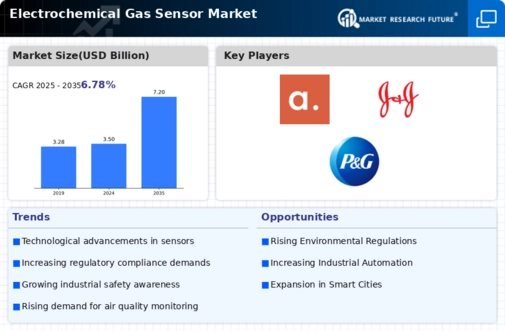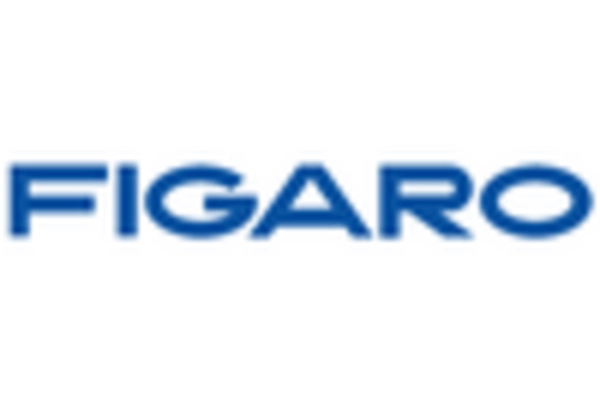Industrial Safety Regulations
The Electrochemical Gas Sensor Market is significantly influenced by stringent industrial safety regulations. Various sectors, including manufacturing, oil and gas, and chemical processing, are mandated to implement gas detection systems to protect workers from hazardous environments. Regulatory bodies have established guidelines that necessitate the use of reliable gas sensors to monitor toxic and flammable gases. This regulatory landscape is likely to propel the market, as companies seek to comply with safety standards and avoid penalties. The market for electrochemical gas sensors is anticipated to expand as industries prioritize worker safety and invest in advanced detection technologies.
Rising Demand for Air Quality Monitoring
The increasing awareness regarding air quality and its impact on health is driving the Electrochemical Gas Sensor Market. As urbanization accelerates, cities are experiencing heightened pollution levels, prompting governments and organizations to invest in air quality monitoring systems. According to recent data, the air quality monitoring market is projected to grow significantly, with electrochemical sensors playing a crucial role in this expansion. These sensors provide real-time data on harmful gases, enabling timely interventions. Consequently, the demand for electrochemical gas sensors is expected to rise, as they are essential for ensuring compliance with environmental regulations and safeguarding public health.
Technological Innovations in Sensor Design
Technological advancements in sensor design are reshaping the Electrochemical Gas Sensor Market. Innovations such as miniaturization, enhanced sensitivity, and improved selectivity are making electrochemical sensors more effective and versatile. These advancements enable the development of compact sensors that can be integrated into various applications, from personal safety devices to large-scale industrial monitoring systems. The market is witnessing a shift towards smart sensors that offer connectivity features, allowing for remote monitoring and data analysis. As these technologies evolve, the demand for advanced electrochemical gas sensors is expected to increase, catering to diverse applications across multiple sectors.
Growing Adoption in Automotive Applications
The automotive sector is increasingly adopting electrochemical gas sensors, contributing to the growth of the Electrochemical Gas Sensor Market. With the rise of stringent emission regulations, automotive manufacturers are integrating these sensors into vehicles to monitor exhaust gases and ensure compliance with environmental standards. The demand for fuel-efficient and low-emission vehicles is driving innovation in sensor technology, leading to the development of more accurate and reliable sensors. As the automotive industry continues to evolve towards sustainability, the role of electrochemical gas sensors in monitoring vehicle emissions is likely to expand, further propelling market growth.
Increased Focus on Environmental Sustainability
The Electrochemical Gas Sensor Industry. Governments and organizations are increasingly prioritizing initiatives aimed at reducing carbon footprints and improving air quality. This focus has led to the implementation of various environmental monitoring programs that rely on accurate gas detection technologies. Electrochemical gas sensors are essential tools in these initiatives, providing critical data for assessing pollution levels and enforcing regulations. As sustainability efforts intensify, the demand for electrochemical gas sensors is expected to rise, as they play a vital role in achieving environmental goals and promoting public health.

















Leave a Comment